Yes, Cats Play Fetch. Now Scientists Are Finally Figuring Out Why
A new study from the University of Sussex looks at a surprisingly unexpected animal behavior — cats who love to play fetch.

A round of fetch brings to mind long summer days in the park with a tennis ball-obsessed dog, but this fun game isn’t canine-exclusive. While cats are better known for their stalking abilities, some felines also enjoy some fetching playtime with their pet parents. But because this back-and-forth behavior is so closely associated with dogs, animal psychology researchers haven’t closely studied this behavior in Felis catus — until now.
A team of animal psychologists at the University of Sussex decided to gather data on fetching cats (cats that fetch...not cats that are fetching) and designed a survey for families of these cats that might elucidate any behavioral patterns and potential motivations. The answers inform cat owners a little more about what’s worth knowing about a fetch-playing cat.
After combing through the responses, the team published a paper on Thursday in the journal Scientific Reports examining the fetching behaviors of 1,154 kitties across 924 respondents. This study is only the beginning of a deeper exploration into why this stereotypical canine pastime can be a surprising hobby of your own favorite feline.
A Fun, Fluffy Game of Fetch
First author Jemma Forman, an animal psychology doctoral researcher at the University of Sussex, tells Inverse by email that, in general, cat play behavior resembles hunting behavior (biting, chasing, and leaping, etc.), which tends to be a solitary activity. However, fetch “adds the behavioral element of retrieval back to their owners,” Forman says. “So it’s interesting to see how solitary playing/hunting behaviors are being adapted for inter-specific play with owners.”
In the survey, the researchers asked cat parents to describe who initiates and ends games, how many times they play fetch every month, their cat’s favorite fetch toys, and how this playtime activity first began. One of the most interesting findings is that more than 94 percent of cat owners surveyed said this behavior arose without training. This shows that cats come to desire this activity on their own without external influence.
The researchers combed this data for more potentially meaningful correlations, including which breeds were more inclined to fetch their favorite toys. Among the 1,100-plus kitties, only 160 were purebred, and of those breeds, Siamese, Bengal, and Ragdoll cats were the top three fetching groups. And many fetch sessions weren’t just one-and-done, as so many cat activities can be. According to the study, 59 percent of fetching cats played this game up to ten times each month.
While cats famously love playing with non-toy items like toilet paper rolls and bottle caps, toys were the most popular item to be fetched according to survey results; over 38 percent of cats fetched toys, as opposed to twist ties, clothing items, string, and other scraps.
With cats being notoriously picky pets, many respondents reported that their pets would only play fetch under certain circumstances. For example, one participant said their cat would only retrieve a pom-pom of a particular size, rejecting larger or smaller pom-poms. Other cats would only play fetch in specific locations or with particular people.
While Forman and her team didn’t track the duration of fetch sessions, they did ask about the number of retrievals in the most recent game. Most commonly, participants reported between 1 and 5 retrievals per session, followed by 6 to 10 retrievals as the next most common. Forman writes these findings indicate games of kitty fetch are quite short, but the cats would often play with the toy independently before bringing it back.
Your retriever kitty and you
So what does this all say about your fetch-obsessed feline? Forman says that this behavior seems to be “intrinsically motivated,” as in the cats initiate it themselves without proper training or even an example from another dog or fetching cat. A majority of cats also began this type of play early, as 61 percent started fetching as kittens. This is to say that if cats didn’t come to fetch on their own, it'll take much more work to instill this playtime behavior in them (though it’s not impossible).
Though cats have a knack for making their desires known, pet parents still ought to be attuned to their kitty’s behavior in case they’re asking for a round of fetch, such as “if the cat brings them an object” or “looks towards them expectantly next to a toy,” Forman says. Also, make sure fetch toys are lightweight and large enough not to pose a swallowing risk — cats need to safely tote their makeshift retrieval object, whether a designer cat toy or discarded twist tie, back and forth in their mouths.
Forman and her team are now developing a follow-up study that’s recruiting participants who currently own a fetch-playing cat. And for any new kitten parents, look out for the telltale signs — just because you have a cat doesn’t mean they’re not up for a rousing game of fetch.